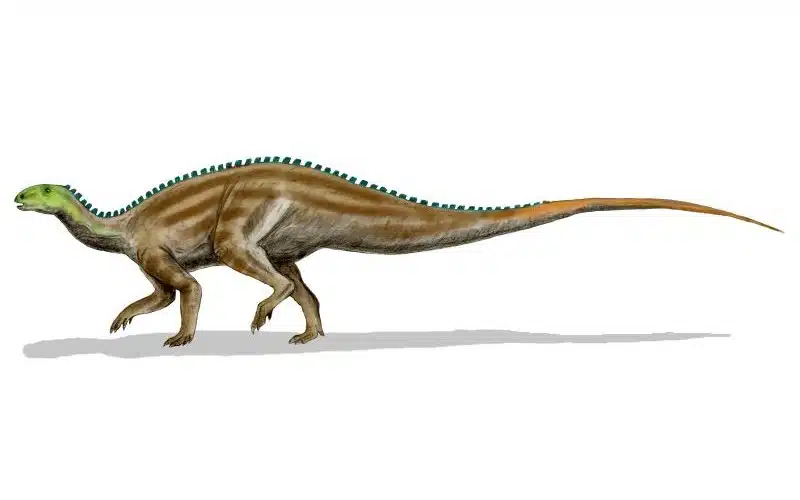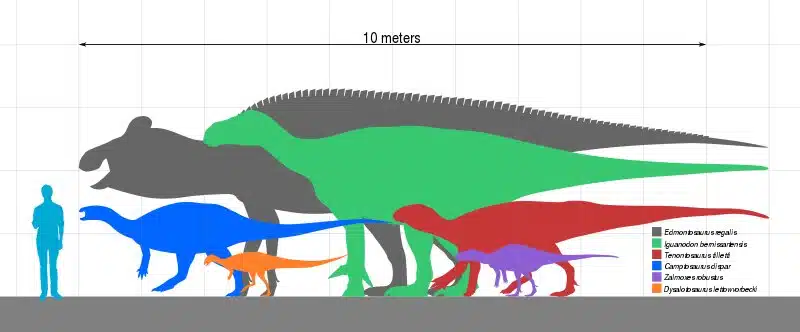In this post I will introduce you to a fascinating dino known as Tenontosaurus. This dinosaur, whose name intriguingly translates to “sinew lizard,” was a remarkable specimen that roamed the Earth over a hundred million years ago. So, buckle up and get ready to explore the world of this ancient creature, its unique characteristics, and the environment it called home.
Tenontosaurus Key Facts
| Keyword | Fact |
|---|---|
| Tenontosaurus pronunciation | ten-ON-toe-sore-us |
| Meaning of name | Sinew lizard |
| Group | Sauropod |
| Type Species | Tenontosaurus tilletti |
| Diet | Herbivore |
| When it Lived | 122.46 to 100.5 MYA |
| Period | Early Cretaceous |
| Epoch | Late/Upper Aptian to Albian |
| Length | 23.0 ft |
| Height | 4.9 ft |
| Weight | 1.0 ton |
| Mobility | Moved on two legs, or all four |
| First Discovery | 1903 by American Museum of Natural History (AMNH) expedition |
| Location of first find | Big Horn County, Montana |
| First Described by | 1970 by John Ostrom |
| Holotype | OMNH 58340 |
Tenontosaurus Taxonomy and Timeline

Let’s start our journey by understanding the origins of Tenontosaurus. The name is derived from the extensive tendons found on its back and tail. It comes from the Greek words “tenon,” meaning sinew and “sauros” meaning lizard.”
In terms of taxonomy, it belongs to the Sauropoda group, specifically the Iguanodontidae family. The genus includes the type species Tenontosaurus tilletti. Like its relatives, this dinosaur was an herbivore, meaning it primarily consumed plant matter.
It lived during the Early Cretaceous period, specifically from the Late Aptian to Albian epochs. This places its existence in a time when dinosaurs were the dominant terrestrial vertebrates.
Discovery & Fossil Evidence
The first fossil was discovered in 1903 in Big Horn County, Montana by an expedition from the American Museum of Natural History (AMNH). However, it wasn’t until 1970 that the dinosaur was officially described by John Ostrom, who named it Tenontosaurus. The holotype–or the specimen used to describe the species–is known as OMNH 58340.
Subsequent finds have been made in various locations across the United States, including Arizona, Idaho, Maryland, Oklahoma, Texas, Utah, and Wyoming. These discoveries have provided a wealth of information about the Tenontosaurus and contributed significantly to our understanding of this dinosaur.
Tenontosaurus Size and Description
Before we delve into the specifics, let’s take a moment to visualize this dinosaur. Picture a medium to large-sized dinosaur moving on two or four legs with an unusually long, broad tail stiffened with a network of bony tendons. Now, let’s delve deeper into its physical characteristics.
Short description of Tenontosaurus
Tenontosaurus was a large ornithopod characterized by its unique body shape and structure. Its head was relatively small compared to its body, with a beak-like mouth for grazing on vegetation. The tail was its most distinctive feature. It was unusually long and broad, stiffened by a network of bony tendons. This tail likely played a crucial role in the dinosaur’s locomotion and balance. The skin is believed to have been scaly like many dinosaurs, although no direct evidence of this exists.
Size and Weight of Type Species

This was a medium to large-sized dinosaur. It measured approximately about 23 feet in length. As for its weight, estimates suggest that it weighed around 1.0 US tons. These figures, however, are estimates and may vary based on different sources and methods of calculation.
It’s important to note that these measurements are averages and individual Tenontosaurus may have varied in size. The size of a dinosaur can depend on various factors, including its age, sex, and overall health. Despite these variations, the Tenontosaurus was undoubtedly a sizable creature.
The Dinosaur in Detail
Tenontosaurus was a truly remarkable creature with several unique features that set it apart from other dinosaurs. Its most distinguishing characteristic was undoubtedly its extensive network of tendons, particularly in the tail region. These tendons gave the dinosaur its name and likely played a crucial role in its locomotion and balance. They may have also served a defensive purpose by allowing the Tenontosaurus to whip its tail at predators.
The neck was long and slender, connecting the head to a robust body. The vertebrae, particularly in the tail region, were reinforced with extensive tendons that give the dinosaur its name. The limbs were sturdy and capable of supporting the dinosaur’s weight whether it moved on two or all four legs.
This dinosaur also contributes significantly to our understanding of dinosaur evolution. Its fossils provide valuable insights into the transition from bipedal to quadrupedal locomotion in dinosaurs, a key evolutionary milestone. The Tenontosaurus, with its ability to move on two or all four legs, represents an intermediate stage in this transition.
Tenontosaurus in its Natural Habitat
This dinosaur lived during the Early Cretaceous period–a time of significant environmental change. The climate during this period was warm with high sea levels creating numerous shallow inland seas. The geography was diverse, ranging from lush forests to arid deserts. The vegetation was dominated by flowering plants, which were just beginning to diversify and spread.
As an herbivore, Tenontosaurus would have been a primary consumer, feeding on the abundant plant life. Its beak-like mouth and grinding teeth would have been well-suited to this diet. It’s likely that it was a selective feeder that chose the most nutritious plants available.
This was a terrestrial dinosaur that was capable of moving on two or all four legs. This versatility would have been advantageous in its diverse environment, allowing it to navigate different terrains and escape from predators. Its long, tendon-stiffened tail would have been a formidable defensive weapon against predators.
Its environment was diverse, ranging from arid conditions at the start of the Albian period that eventually changed to a tropical climate featuring river deltas and swamps during the wet seasons and a savannah climate during the dry. Despite these changing climates, this dinosaur continued to thrive, as evidenced by its numerous remains in the fossil record.
Its diet consisted of plant matter and it likely had a selective feeding behavior, choosing the most nutritious plants available. Its long forelimbs and strong finger bones suggest that it was primarily quadrupedal but could also rear up on its hind legs to reach a greater range of plant material. This adaptability in feeding behavior would have given it a significant advantage in its changing environment.
Interesting Points about Tenontosaurus
- The tail, which made up more than half its total body length, was supported by a network of strong tendons that ensured it was always carried erect off the ground.
- Many remains have been found in close proximity to fossils of the carnivorous dinosaur Deinonychus, suggesting possible predator-prey relationships.
- It was able to adapt to life in different kinds of environments, from arid conditions to tropical climates.
- Despite being primarily quadrupedal, it could rear up on its hind legs to reach a greater range of plant material.
- Studies suggest that Tenontosaurus individuals were able to reproduce before they were fully grown.
Contemporary Dinosaurs
In the prehistoric world where this dinosaur roamed, it was not alone. It shared its environment with Deinonychus, Acrocanthosaurus, and Sauroposeidon, each playing a unique role in the ecosystem.
The herbivorous Tenontosaurus might have grazed peacefully, its size offering some protection against smaller predators. Yet, the presence of the nimble and ferocious Deinonychus could have introduced a certain tension into the landscape. The potential predator-prey relationship between these two dinosaurs paints a vivid picture of the survival dynamics of their time.
Acrocanthosaurus, another contemporary, was a larger predator. Its presence might have posed a significant threat to Tenontosaurus. However, the size and strength of Tenontosaurus could have made it a challenging prey even for the mighty Acrocanthosaurus. This dynamic interplay between the hunter and the hunted adds a layer of complexity to our understanding of Tenontosaurus’s existence.
Sauroposeidon, a gigantic herbivore, towered above all. Its sheer size and the fact that it shared the same environment could have influenced the behavior and feeding patterns of Tenontosaurus. Despite being fellow herbivores, the vast difference in size and possibly dietary preferences would have shaped their interaction and ensured a balance in the ecosystem. This intricate coexistence of Tenontosaurus with its contemporaries offers a fascinating glimpse into the rich and complex world of these prehistoric giants.
List of All Dinosaurs
We have created a list of all dinosaurs we have covered here, sorted across the seven main groups of dinosaurs. We also include information about their type of diet, (omnivore, herbivore or carnivore) and the time they lived.
Frequently Asked Questions
The name translates to “sinew lizard,” referencing the extensive tendons found on its back and tail.
It lived during the Early Cretaceous period, specifically from the Late Aptian to Albian epochs. This places it roughly between 122.46 and 100.5 million years ago.
It was an herbivore, meaning it primarily consumed plant matter.
The first fossil was discovered in Big Horn County, Montana in 1903.
This was a medium to large-sized dinosaur, measuring approximately 7.0 meters (about 23 feet) in length and weighing around 900 kilograms (nearly 2000 lbs).
Yes, it was capable of moving on two or all four legs. Its long, tendon-stiffened tail likely served as an effective counterbalance, allowing it to rear up on its hind legs.
Sources
- https://academic.oup.com/zoolinnean/article-abstract/55/2/151/2670940?redirectedFrom=fulltext
- https://www.biodiversitylibrary.org/part/313819
- https://www.researchgate.net/publication/349840352_Systematics_and_paleobiology_of_a_new_articulated_axial_specimen_referred_to_Iguanodon_cf_galvensis_Ornithopoda_Iguanodontoidea
- https://www.cambridge.org/core/journals/journal-of-paleontology/article/new-smallbodied-ornithopods-dinosauria-neornithischia-from-the-early-cretaceous-wonthaggi-formation-strzelecki-group-of-the-australianantarctic-rift-system-with-revision-of-qantassaurus-intrepidus-rich-and-vickersrich-1999/D6FEF2CD3EC1CAAD8F41B6ED73EC356C
- https://www.tandfonline.com/doi/abs/10.1080/14772019.2017.1371258?journalCode=tjsp20
Please note that the information in this article is based on various sources, drawing on scientific research, fossil evidence, and expert analysis. The aim is to provide a comprehensive and accurate overview of the Tenontosaurus, but please be aware that our understanding of dinosaurs and their world is constantly evolving as new discoveries are made.
This article was last fact checked: Joey Arboleda, 06-13-2023
Featured Image Credit: Nobu Tamura, CC BY-SA 3.0, via Wikimedia Commons

